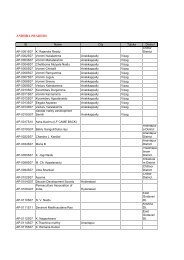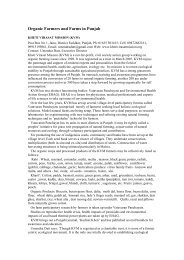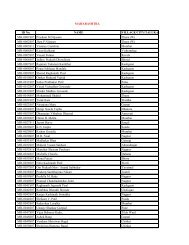Western Ghats Kokum Foundation - Organic Farming Association of ...
Western Ghats Kokum Foundation - Organic Farming Association of ...
Western Ghats Kokum Foundation - Organic Farming Association of ...
Create successful ePaper yourself
Turn your PDF publications into a flip-book with our unique Google optimized e-Paper software.
In-vitro Culture <strong>of</strong> Garcinia indica Choisy - A Review<br />
M. Baskaran and S. Krishnan<br />
Department <strong>of</strong> Botany, Goa University, Goa - 403206, India.<br />
Garcinia indica Choisy, an endemic plant to <strong>Western</strong> <strong>Ghats</strong> <strong>of</strong> India, belongs to the<br />
family Clusiaceae and is popularly known as <strong>Kokum</strong> (Shetty and Kaveriappa 2001, Naithani<br />
et al., 1997). It is a dioecious tree flowers in November-February and fruits ripen in the<br />
April-June (Anonymous 1956, Sawant et al., 1999). The conventional way <strong>of</strong> propagation <strong>of</strong><br />
<strong>Kokum</strong> is by seeds. These natural seedling populations, due to cross pollination and<br />
heterozygous nature <strong>of</strong> the trees, has abundant variation with respect to growth, habit,<br />
flowering and fruiting season, fruit yield and morphological and biochemical<br />
characteristics <strong>of</strong> fruits (Korikanthimath and Desai 2005). Also, the early ripening and high<br />
yielding genotypes are preferred, because harvesting and processing <strong>of</strong> fruits need to be<br />
completed before the onset <strong>of</strong> monsoon (end <strong>of</strong> April or beginning <strong>of</strong> June) in the <strong>Western</strong><br />
India (Chabukswar and Deodhar. 2005). To overcome the above problems, the production<br />
<strong>of</strong> high yielding elite clones is necessary. In-vitro culture studies have been carried out by<br />
various scientific groups and they have developed and standardized the protocol for mass<br />
multiplication <strong>of</strong> <strong>Kokum</strong> plants through embryogenesis and multiple shoot formation. This<br />
review summarizes all the tissue culture work carried out till date on <strong>Kokum</strong>.<br />
Somatic Embryogenesis<br />
Direct somatic embryogenesis was achieved by Thengane et al. (2006). They have<br />
cultured immature seeds on Woody Plant Medium (WPM) supplemented with 6-benzyl<br />
amino purine (BAP) 4.44–22.19 micro mole (µm) alone or in combination with anaphthaleneacetic<br />
acid (NAA) (2.69 µm) found somatic embryos <strong>of</strong> 80% frequency within a<br />
period <strong>of</strong> 2–3 weeks. Embryo induction was exhibited all over the explant surface. The<br />
highest number <strong>of</strong> somatic embryos was recorded in higher concentration <strong>of</strong> BAP (22.19<br />
µm). The origin <strong>of</strong> the embryos was confirmed histologically from sub-epidermal layer <strong>of</strong><br />
the seed. Sub-cultures <strong>of</strong> somatic embryos in same media did not support the embryo<br />
maturation up to 10 weeks. However, it increased the embryogenic mass. Maturation <strong>of</strong><br />
embryos was achieved in the medium containing BAP (16.08 µm) in combination with<br />
indole-3-acetic acid (IAA) (2.85–5.71 µm) and/or kinetin (KN) (4.65 µm) after 12 weeks <strong>of</strong><br />
culture. After maturation, embryos were converted into shoot pole. It was reported that the<br />
maximum number <strong>of</strong> mature embryos was obtained on the medium containing BAP (16.08<br />
µm), IAA (5.71 µm) and kinetin (4.65 µm). Within 24 weeks, 43.80% <strong>of</strong> embryos were<br />
grown in to well-developed shoots.<br />
For rooting, well-developed shoot pole <strong>of</strong> size 1.5–2.0 cm were transferred to the<br />
rooting media and the rooting was observed in 20-25 days. The maximum number <strong>of</strong> root<br />
was induced in NAA (10.74 µm) with indole-3-butyric acid IBA (4.90 µm). However, roots<br />
induced on NAA and IBA combination observed faster growth than those with<br />
incorporation <strong>of</strong> indole-3-propionic acid (IPA) in the rooting media. The rooted plantlets<br />
were transferred to half-strength MS (Murashige and Skoog) medium supplemented with<br />
59<br />
Resource Book on <strong>Kokum</strong> (Garcinia indica Choisy)<br />
<strong>Western</strong> <strong>Ghats</strong> <strong>Kokum</strong> <strong>Foundation</strong>, Panaji - Goa





